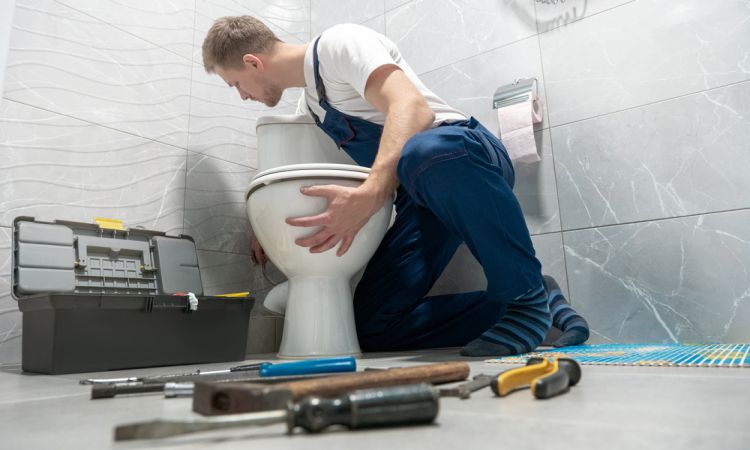 The toilet is one of the many fixtures in your home that relies on a lot of water. This makes it a likely place to have leaks now and then. These are not just potential slipping hazards and sources of foul smells; leaking toilets can easily cost you a lot in terms of water waste, home damage, and sanitation. They’re a danger to your family’s health and your budget. Wise homeowners should do what they can to prevent leaks in the first place and handle them when they occur.
The toilet is one of the many fixtures in your home that relies on a lot of water. This makes it a likely place to have leaks now and then. These are not just potential slipping hazards and sources of foul smells; leaking toilets can easily cost you a lot in terms of water waste, home damage, and sanitation. They’re a danger to your family’s health and your budget. Wise homeowners should do what they can to prevent leaks in the first place and handle them when they occur.
Fixing a leaking toilet isn’t complicated, and many people can do it by themselves. But there are times when the issue is much trickier than you can handle. For that, you can always look up the top plumbers in the Inner West or your particular area for professional help.
However you choose to go about it, here’s a list of reasons why a toilet may start leaking and how to fix them:
1. Cracks
Sometimes, it’s something as simple as a crack. Depending on the location, you can just drain the water and then apply a waterproof epoxy seal.
But there are times when this won’t be enough. The toilet pan or base, in particular, needs some thorough inspection once you see cracks. This is because it bears much of the weight of the entire toilet along with the water. These cracks may burst, causing damage to your bathroom and yourself.
As a rule, get a replacement if the crack penetrates the bowl. Call your trusted plumber for aid, in this case.
2. Leaking Toilet Ring
You may find wastewater leaking out from the bottom. If that’s the case, consider removing the toilet to inspect the ring. This is the seal that connects it to the plumbing system. A weakness in the lining may explain the seeping of water into your bathroom floor.
Before working on the toilet, shut off the supply valve and remove the supply hose from the bottom. You should also ensure the toilet tank has drained completely. Use a plunger to empty it completely if there is still some water left.
If the floor is wet, give it time to dry. Then, you can remove the toilet as per the manufacturer’s instructions. From there, you can remove the damaged ring and replace it. Remember to tighten the nuts and place the bolts over the washers. You can hire a plumber to guide you through the whole process.
3. Overflowing Pipes
The pipes themselves may have issues, making your toilet leak. A common cause for this is that the ballcock can’t entirely close off the water tank valve due to damage. Or, the washer may be too worn out to form a proper seal.
Unless the leak is extensive, you can handle this problem yourself. Buy replacement parts from your local store and follow the instructions on how to remove old ones to install them.
4. Clogging
This is one of the more common plumbing issues experienced in many homes. The tell-tale signs of a clogged toilet include foul smells and water draining slowly into your pipes.
Using a plunger is usually enough. But some cases are harder to deal with, like if the clogs are the result of cracked cement or loosened parts. For these, you should let a professional plumber take a look.
5. Damaged Flapper
The toilet flapper is located within the toilet tank and connects the bowl to the outlet. It closes the outlet and rises to let in water as you flush. After that, it returns to its place.
When your toilet has a damaged flapper, you’ll notice the water flowing constantly even when you’re not flushing. To fix it, just buy a new flapper and replace the old one.
6. Corroded Fill Valves
When you hear loud noises from your toilet when you flush, it’s time to replace the fill valve. These regulate water refill in the bowl after every flush. Replacing a rusted flush valve is relatively easy, and you don’t need help from a professional.
Start by locating the shutoff valve that controls the water supply and closing it. Flush the toilet to get rid of the water in the tank and remove the plastic cap. Do the same with the shutoff valve to get the debris off. After that, replace the seal with a new one and reposition the cap.
7. Leaking Toilet Tanks
The toilet tank itself may leak, usually when the tank and toilet seal come off. This leakage can seep into your walls and encourage mold growth. On top of that, it wastes a lot of water as the tank drains quickly and needs a constant refill.
The best way to handle a leaky toilet tank is to replace the seal with a new one. Remember to place the tank in such a way that it doesn’t wobble. Also, don’t over-tighten the tank, as it can easily break.
Patch Them Before You Get Bigger Problems
Dealing with toilet issues is a smelly affair. But you have to do it if you want to save water and keep your bathroom as a convenient, relaxing space. You can always call on a professional plumber to handle drainage-related problems. Until then, consider checking if your toilet needs fixing today.




